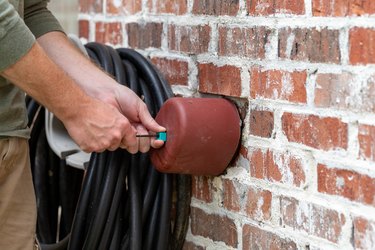
When wintry weather hits, it's crucial to keep your home protected, which means taking the appropriate steps to protect your water pipes. When water freezes inside pipes, the water molecules expand, putting substantial pressure on your pipes until they may finally rupture. Pipes that freeze most commonly include water pipe supply lines in unheated areas (like your basement), pipes that are exposed to severe cold (like swimming pool supply lines and outdoor hose bibs), and pipes that run against exterior walls with no insulation.
Learn how to keep PVC pipes from freezing so you never have to worry about dealing with costly, time-consuming water damage when they burst.
Video of the Day
Video of the Day
Know When to Replace Your Pipes
When it comes to protecting your pipes, engaging in certain preventive methods now can save you hours of headache-inducing repairs in the future. (Yes, this goes for people who live in temperate climates too.) It's important to note that all PVC pipes have a shelf life of around roughly 50 to 70 years. So have a plumber inspect your pipes or go ahead and replace them before freezing weather strikes if they're nearing the end of their life span. On that note, it's a good idea to call a professional to have your heating and plumbing system serviced every year so that you can remedy any minor issues before they become major ones.
Best Methods for Preventing Frozen Pipes
Even if there's only a small chance of freezing temperatures, your PVC pipes should be insulated enough to maintain temperatures above 32 degrees Fahrenheit. Fiberglass insulation is best, but foam insulation works well too. The latter is cheaper, and you can do it yourself, while fiberglass may require a professional.
When the temperature drops, it's important to close and drain any outdoor faucets, and to protect these with faucet covers. Locate the shut-off valve on the water supply line that feeds your outdoor faucet(s) and close it, and remove any garden hoses from the outdoor spigot (just be sure to drain the line, wipe down the hose, and store the hose in a shed or another indoor space). And, if the weather predicts subzero temperatures, open your taps to a trickle to keep water moving.
Another option is to install water sensors in your home anywhere that's at risk of water damage. These sensors can detect leaks before they get out of hand. In addition, if you'll be leaving the house for a long period of time, consider leaving the thermostat set anywhere from 55 to 60 degrees Fahrenheit. Pipes often freeze when people go out of town and turn off the heat.
How to Safely Thaw Frozen Pipes
Preventing pipes from freezing in the first place is always preferable, but if you're already dealing with frozen pipes, it can be helpful to know how to safely thaw them. If you turn on a faucet in your home and only a trickle of water comes out, this is likely because your pipes are already frozen. You may still have a chance of being able to thaw them provided that you act quickly. Note that using a hair dryer or electric heater is an unsafe way to heat up your frozen pipe. Instead, run warm water through the pipe to slowly melt the ice and apply heat to the pipe by wrapping it in hot towels.